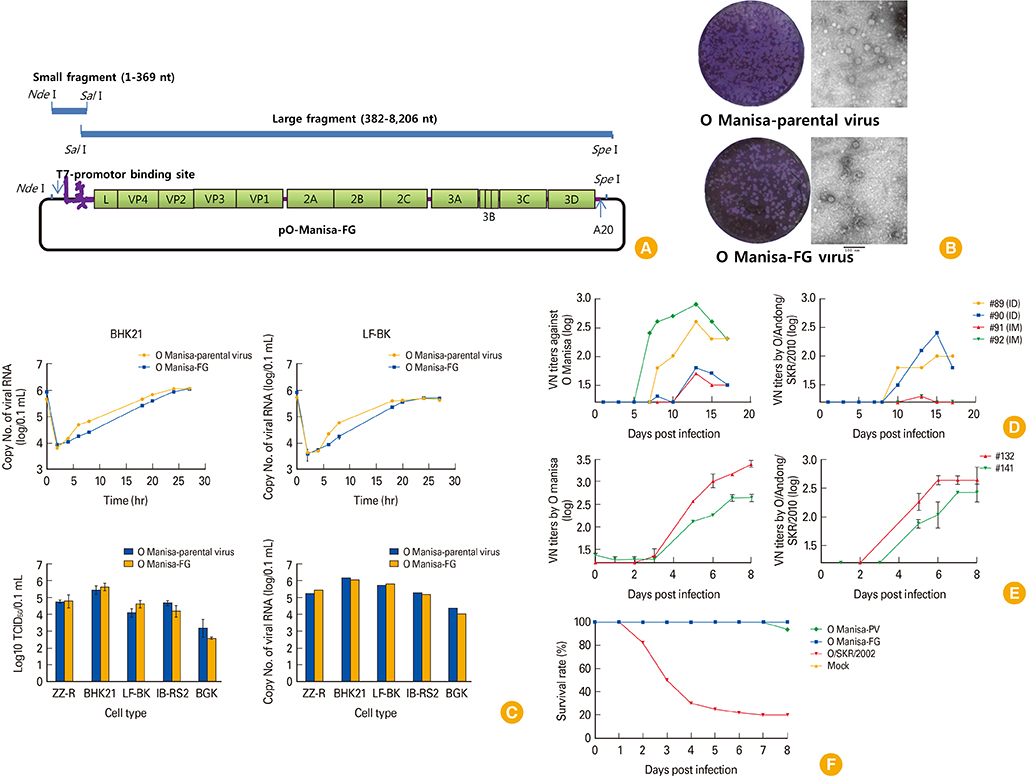Clin Exp Vaccine Res.
2015 Jan;4(1):114-118. 10.7774/cevr.2015.4.1.114.
Antigenic properties and virulence of foot-and-mouth disease virus rescued from full-length cDNA clone of serotype O, typical vaccine strain
- Affiliations
-
- 1Animal and Plant Quarantine Agency, Anyang, Korea. parkjhvet@korea.kr
- 2Clinical Research Center of the Affiliated Hospital of Guangdong Medical College, Zhanjiang, China.
- KMID: 2049115
- DOI: http://doi.org/10.7774/cevr.2015.4.1.114
Abstract
- We cloned the full-length cDNA of O Manisa, the virus for vaccinating against foot-and-mouth disease. The antigenic properties of the virus recovered from the cDNA were similar to those of the parental virus. Pathogenesis did not appear in the pigs, dairy goats or suckling mice, but neutralizing antibodies were raised 5-6 days after the virus challenge. The utilization of O Manisa as a safe vaccine strain will increase if recombinant viruses can be manipulated by inserting or removing a marker gene for differential serology or replacing the protective gene from another serotype.
Keyword
MeSH Terms
Figure
Reference
-
1. Elnekave E, Li Y, Zamir L, et al. The field effectiveness of routine and emergency vaccination with an inactivated vaccine against foot and mouth disease. Vaccine. 2013; 31:879–885.
Article2. Hema M, Chandran D, Nagendrakumar SB, Madhanmohan M, Srinivasan VA. Construction of an infectious cDNA clone of foot-and-mouth disease virus type O 1 BFS 1860 and its use in the preparation of candidate vaccine. J Biosci. 2009; 34:45–58.
Article3. Knowles NJ, He J, Shang Y, et al. Southeast Asian foot-and-mouth disease viruses in Eastern Asia. Emerg Infect Dis. 2012; 18:499–501.
Article4. Rajasekhar R, Hosamani M, Basagoudanavar SH, et al. Rescue of infective virus from a genome-length cDNA clone of the FMDV serotype O (IND-R2/75) vaccine strain and its characterization. Res Vet Sci. 2013; 95:291–297.
Article5. Li P, Bai X, Lu Z, et al. Construction of a full-length infectious cDNA clone of inter-genotypic chimeric foot-and-mouth disease virus. Wei Sheng Wu Xue Bao. 2012; 52:114–119.6. Lu S, Zhao Q, Liu X, et al. Construction of an infectious cDNA clone derived from foot-and-mouth disease virus O/QYYS/s/06. Sheng Wu Gong Cheng Xue Bao. 2009; 25:982–986.7. Li P, Bai X, Sun P, et al. Evaluation of a genetically modified foot-and-mouth disease virus vaccine candidate generated by reverse genetics. BMC Vet Res. 2012; 8:57.
Article8. Chang Y, Zheng H, Shang Y, et al. Recovery of infectious foot-and-mouth disease virus from full-length genomic cDNA clones using an RNA polymerase I system. Acta Biochim Biophys Sin (Shanghai). 2009; 41:998–1007.
Article9. Liu G, Liu Z, Xie Q, et al. Generation of an infectious cDNA clone of an FMDV strain isolated from swine. Virus Res. 2004; 104:157–164.
Article10. Zibert A, Maass G, Strebel K, Falk MM, Beck E. Infectious foot-and-mouth disease virus derived from a cloned full-length cDNA. J Virol. 1990; 64:2467–2473.
Article11. Uddowla S, Hollister J, Pacheco JM, Rodriguez LL, Rieder E. A safe foot-and-mouth disease vaccine platform with two negative markers for differentiating infected from vaccinated animals. J Virol. 2012; 86:11675–11685.
Article12. Li P, Bai X, Cao Y, et al. Expression and stability of foreign epitopes introduced into 3A nonstructural protein of foot-and-mouth disease virus. PLoS One. 2012; 7:e41486.
Article13. Ito N, Takayama-Ito M, Yamada K, Hosokawa J, Sugiyama M, Minamoto N. Improved recovery of rabies virus from cloned cDNA using a vaccinia virus-free reverse genetics system. Microbiol Immunol. 2003; 47:613–617.
Article14. Escarmis C, Toja M, Medina M, Domingo E. Modifications of the 5' untranslated region of foot-and-mouth disease virus after prolonged persistence in cell culture. Virus Res. 1992; 26:113–125.
Article15. Saiz M, Gomez S, Martinez-Salas E, Sobrino F. Deletion or substitution of the aphthovirus 3' NCR abrogates infectivity and virus replication. J Gen Virol. 2001; 82:93–101.
Article16. Grubman MJ, Baxt B, Bachrach HL. Foot-and-mouth disease virion RNA: studies on the relation between the length of its 3'-poly(A) segment and infectivity. Virology. 1979; 97:22–31.
Article
- Full Text Links
- Actions
-
Cited
- CITED
-
- Close
- Share
- Similar articles
-
- Isolation of Echovirus Serotype 25 from Patient with Hand , Foot and Mouth Disease in Pusan , 1998
- Construction of A Stable Full-Length cDNA Clone of Japanese Encephalitis Virus Strain SA14-14-2 Using Low Copy Number Plasmid
- Low topotype diversity of recent foot-and-mouth disease virus serotypes O and A from districts located along the Uganda and Tanzania border
- Establishment and characterization of an infectious cDNA clone of a classical swine fever virus LOM strain
- New foot-and-mouth disease vaccine, O JC-R, induce complete protection to pigs against SEA topotype viruses occurred in South Korea, 2014–2015


